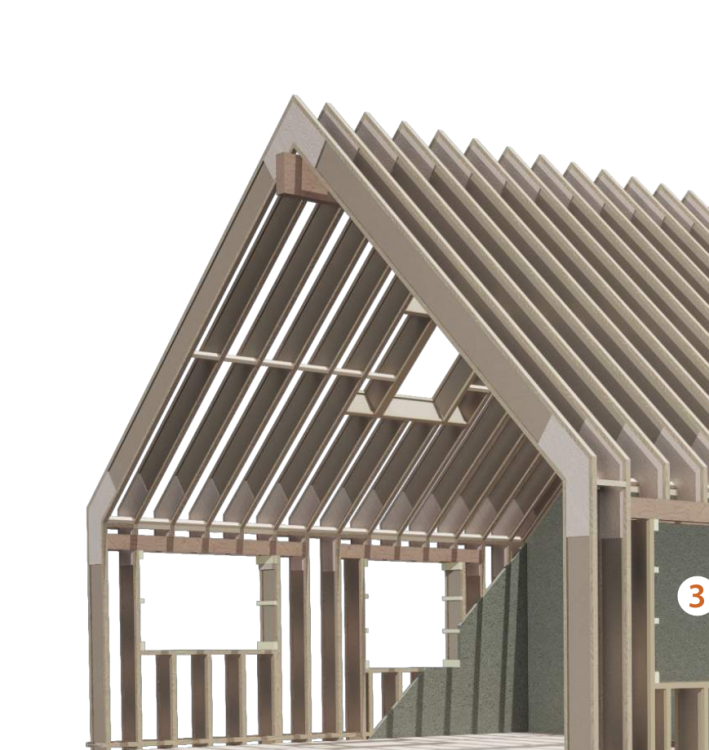
thaldine
Members-
Posts
21 -
Joined
-
Last visited
Personal Information
-
Location
Highland
Recent Profile Visitors
The recent visitors block is disabled and is not being shown to other users.
thaldine's Achievements

Member (3/5)
0
Reputation
-
Avoiding steel wind frame with portal I-joist frame
thaldine replied to thaldine's topic in Timber Frame
thanks folks -
Has anyone evaluated the cost premium of going for the PH15 build system package versus separately procuring the PHPP modelling, detailing & engineering design, building fabric, windows and doors, external blinds if needed, MVHR system with conditioning and two air tests ? Many thanks in advance
-
Avoiding steel wind frame with portal I-joist frame
thaldine replied to thaldine's topic in Timber Frame
I can't lay my hands on a fully alike depiction but somewhat like this with 350mm deep I joists at 400mm centres. -
I'm planning to have an internal span of 6.7m across a living space in a 1.5 storey build with a ridge height of 6m and eaves of 2.9m with a profiled metal roof. Am I right in thinking this should be possible to achieve with the I-joist frame alone without a steel wind frame ? Thanks in advance.
-
Self-build mortgages for timber frame and timber clad
thaldine replied to thaldine's topic in Self Build Mortgages
Yes, that concurs with what I've so far found. There seemed to be a few lenders for traditional mortgages (i.e. not self-build) for timber frame and timber clad, which I think many folk switch to after the build, but less so for self-build mortgages. I suppose if you think selling to a mortgage dependent buyer or remortgaging, possibly via a lifetime mortgage, is likely to happen before the timber cladding needs replacing (and hence could be rendered instead) the future options are restricted. In my case I may start failing before the cladding though ! -
No, separate: "any architects (and builders)" and "any builders (and architects)"
-
I'm looking for any builders (and architects) with some previous experience of constructing houses designed and built to passivehaus standards (along with "passive slab" foundations) who cover Strathspey and Badenoch. Any pointers gratefully received. Thanks
-
I'm looking for any architects (and builders) with some previous experience of constructing houses designed and built to passivehaus standards (along with "passive slab" foundations) who cover Strathspey and Badenoch. Any pointers gratefully received. Not solely/necessarily Passivehaus Trust certified architects though. Thanks
-
@ProDave I've had a hygrometer for a few years and when the indoor RH undergoes a drop (equally say from 65 to 45 or 50 to 30) as it does when windy the symptoms are at their worst. I'm not sure it is to do with the outright value of the RH but more the fact it drops quickly (possibly leads to the propensity of moisture to condense on a surface to lessen ?) Similarly, when RH is high it can be a bit of an issue too but not as bad as during an aforementioned drop (I wonder if this is because a good proportion of any moisture has been locked up as vapour hence the high RH). No, I've never spent more than a couple of hours in a MVHR equipped house. So when you mention good internal air quality do you put that down to any specific characteristics ? @JohnMo Thanks, I'd landed on the UFH and enthalpy exchanger so it's encouraging to hear it echoed that those may both be worthwhile in relation to the problem !
-
Hello, In all buildings I've so far lived in I have a problem with irritated nasal linings and congestion (not allergy related). Stepping outside relieves it rapidly and coming back indoors brings the symptoms back almost as quickly. Symptoms seem to be worse during windy and/or cold weather (especially when both windy and cold). I suspect the greater the propensity for moisture to evaporate within the home the worse the symptoms get. Based on that, what should I pay attention to in the design, bearing in mind the general guidance to avoid indoor condensation ? The planned build has 0.6 ac/h air tightness and vapour control barrier. Thanks, Trish
-
Does anyone know if anything akin to this is available in the UK ? https://aeroseal.com/aerobarrier/ ..and if so its merits and/or demerits ? Thanks.
-
Any ideas precisely why someone may get nasal congestion indoors when cold and/or windy weather ? Symptoms seems to be correlated with the amount of heating on. Stepping outside relieves it rapidly and coming back indoors brings the symptoms back almost as quickly. Is it simply down to the fact the cold winter air has (relatively speaking) less moisture in it so when that air is heated indoors it dries the mucus membranes out more, or is there more to it than that ? When planning a new build or renovation how might you design for a better indoor environment in this regard ?
-
UFH under existing pine floor boards
thaldine replied to thaldine's topic in Wood & Laminate Flooring
Thanks, was unaware of the distended/compressed plate point. Still waiting to lift the boards to look but I don't think the floor joists are very deep. Still worried the floor boards will have issues with the heat that will be needed ! -
UFH under existing pine floor boards
thaldine replied to thaldine's topic in Wood & Laminate Flooring
Thanks. yes, cold ventilated as suspended bungalow ground floor. Plan is to lap joists with airtight barrier, insulation with UFH pipes clipped on and spreader plates and a vapour control layer. Not considered any makes yet as not even sure proposed method is correctly conceived . The heat source is currently a combi boiler but would be nice to have the option to switch to a heat pump later. Small wood burning stove planned for front room.


